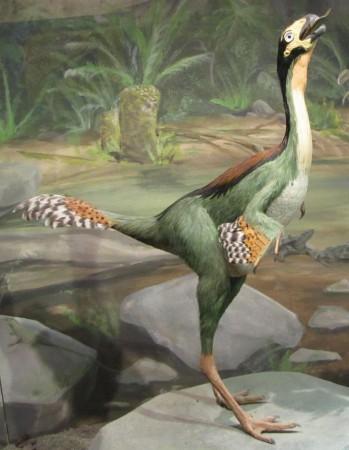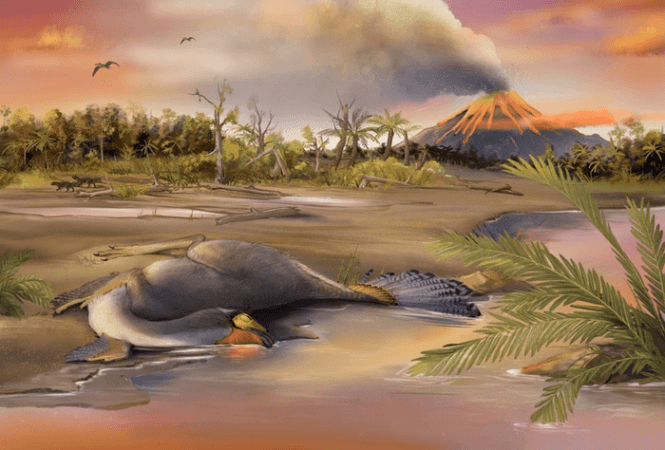When Richard Attenborough's character, John Hammond, explained the extraction of prehistoric dinosaur DNA for their de-extinction in 1993's Jurassic Park, one could not help but marvel at the idea. While mosquitoes containing dinosaur blood—full of DNA—have not been found so far, scores have of dinosaur fossils have been. However, their age makes the preservation of any DNA nearly impossible. Now, scientists have managed to isolate well-preserved cells from a dinosaur fossil over 120 million years old.
A team of researchers from the Chinese Academy of Sciences and the Shandong Tianyu Museum of Nature has isolated exquisitely preserved cartilage cells from the 125-million-year-old fossilized remains of a small dinosaur known as Caudipteryx. The specimen was from the Jehol Biota in Northeast China. One of the isolated cells contained a nucleus along with remnants of organic molecules and chromatin.
"Geological data has accumulated over the years and shown that fossil preservation in the Jehol Biota was exceptional due to fine volcanic ashes that entombed the carcasses and preserved them down to the cellular level," said Dr. LI Zhiheng, co-author of this study, in a statement. The findings of the study were published in the journal Communications Biology.
A Promising Find

Dinosaur fossils are considered extremely old to contain any traces of DNA. Also, attempts at sequencing dinosaur DNA have been unsuccessful. The specimen that led to the discovery, a Caudipteryx, belonged to the Early Cretaceous Jehol biota of Northeast China. Being an omnivorous dinosaur the size of a peacock and having long tail feathers, it lived along the shores of shallow lakes that existed in the region at the time.
A piece of distal articular cartilage—soft and white cartilage that covers the ends of bones and helps in the smooth movements of joints—from the right femur of Caudipteryx was extracted by the team. It was decalcified and analyzed using different chemical and microscopy techniques.
Discovering Cells Within Fossil
The researchers found that silicification following the death of the dinosaur had mineralized all the cells. Silicification is the process by which original skeletal materials are replaced through the simultaneous dissolution of calcium carbonate and precipitation of silica. According to the authors, it is likely that silicification aided in the pristine preservation of these cells.

Two main cell types were discovered during examination: cells that were healthy at the time of the animal's fossilization; and cells in bad health that were porous and fossilized during the process of the dinosaur's gradual death. Dr. Alida Bailleul, corresponding author of this study, averred, "It is possible that these cells were already dying even before the animal died."
The process of cell death occurs naturally throughout the course of an animal's life. However, trying to position a fossilized cell into a particular place within the cell cycle is quite novel in the field of paleontology. Thus, the improvement of cellular imagery in fossils is one of the objectives of the team.
Stumbling Upon Preserved Cell Organelles
In addition to identifying different types of cells, the scientists also isolated a few cells. These cells were stained using a purple chemical called hematoxylin. The chemical binds to the nuclei of cells. After being stained, one of the cells showed the presence of a purple-colored nucleus along with some dark purple thread-like structures.

Simply put, the cell that was millions of years old was perfectly preserved to such an extent that some of its original biomolecules and threads of chromatin were retained. Chromatin is a substance—a complex of tightly packed DNA and protein—within a chromosome. It is found in the cells of all the living organisms in the world.
Therefore, it is likely that residues of original dinosaur DNA may be preserved in fossils, and survived through time. The findings of the current study provide initial data that support this possibility. However, the team stated that for accurate analysis, more refinement was required, particularly the use of chemical methods that are more sophisticated than the staining employed in the study.
Potential for Future Discovery of DNA
While the findings of the research are promising, the authors stress that extensive analysis is necessary in order to comprehend that process that may aid in the preservation of biomolecules within dinosaur cells. This pursuit may also require the development of new methods. This is because the DNA of no dinosaur has been successfully sequenced so far.

Among researchers who study ancient DNA, sequencing techniques are used to confirm whether DNA is preserved within fossils or not. However, these methods have yielded positive results only for young fossils (not older than around one million years), having never worked in the case of dinosaur materials.
Nevertheless, the chemical data obtained through the current study makes a strong case for the potential preservation of DNA in dinosaur fossils. The study also demonstrated that 125-million-year-old cells in a fossil cannot be considered as 100 percent rock; not entirely 'stonified'. Rather, they still retain residues of organic molecules. Now, the next step is to precisely ascertain what these molecules are and whether they possess any amount of biological information and DNA remnants.
"Let's be honest, we are obviously interested in fossilized cell nuclei because this is where most of the DNA should be if DNA was preserved. So, we have good preliminary data, very exciting data, but we are just starting to understand cellular biochemistry in very old fossils. At this point, we need to work more," stressed Dr. Bailleul.














